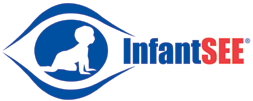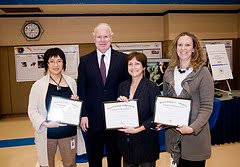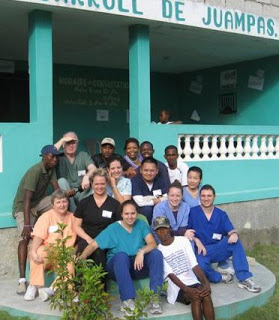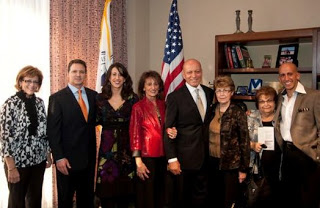MainosMemos contains the latest research and information about eye and vision care of children, developmental disabilities, Traumatic/Acquired Brain Injury and other topics of interest to me (and hopefully you!).
Friday, November 12, 2010
What is 3D Vision Syndrome?
What is 3D Vision Syndrome?
The 3D Vision Syndrome (3DVS) is comprised of a group of symptoms that collectively indicate a functional vision disorder while watching 3D content. 3DVS symptoms include but are not limited to asthenopia, headaches, blurred vision, eyestrain, diplopia (double vision), dizziness/nausea and vision induced motion sickness after watching a 3D movie, 3D television or after playing a 3D video game.
As 3D content becomes readily available through movies, television, video games and the Internet ... if you are not asking your patients questions about the possibility of 3D Vision Syndrome symptomology, you should. With 2-6% of the population having strabismus or amblyopia and up to 56% of adults having symptoms of a binocular vision dysfunction, millions of individuals will not be able to see in 3D or even worse ... while viewing these technological marvels... become ill.
This is a major opportunity for the 3D Entertainment-Techno-Industrial-Complex to work with optometry. If done wisely, companies such as SONY, Panasonic, Samsung, and even Disney can use this new technology as a public health screening for the presence of binocular vision dysfunction in the general population. The good news is that optometrists' have shown thru National Institutes of Health National Eye Institute clinical trials that the functional vision problems associated with 3D Vision Syndrome can be treated effectively and that this treatment lasts.
I would strongly suggest that these companies (and many others) immediately contact the American Optometric Association, the College of Optometrists in Vision Development, the Optometric Education Program Foundation, The American Academy of Optometry and other similar organizations so that a synergistic relationship can ensure that all consumers of 3D content have an opportunity to enjoy their creations. DM
Thursday, November 11, 2010
No cost infant vision exams offered

InfantSee still going strong. Check out these great stories!
http://www.santacruzsentinel.com/localnews/ci_16547063
http://www.goodbabyhealth.com/your-baby-wants-to-see-you.html
http://imnotthatpregnant.blogspot.com/2010/11/its-never-just-check-up-round-these.html
DM
ICO Reception at the AAO

All ICO alumni, students, faculty and staff going to AAO in San Francisco are invited to attend the ICO Alumni Reception hosted by ICO President Dr. Arol Augsburger. The reception will be Friday, Nov. 19, from 7 to 8:30 p.m. in Grand Ballroom B at the San Francisco InterContinental Hotel. Join us for complimentary hors d'oeuvres and beverages during this business-casual gathering, and please invite classmates, prospective students and alumni, too. For more information, contact Connie Scavuzzo, director of alumni development.
ICO Research Symposium Awards

Congratulations to everyone who made ICO's Research Symposium a great success! There were 53 posters presented at the Oct. 29 event. Here are the winners of the day's awards, based on voting by participants:
Most Popular Faculty Poster Ocular Myasthenia Gravis
Authors: Dr. Jessica Condie, Dr. Stephanie Klemencic
Most Popular Student Poster Persistent Fetal Vasculature: Surgical Co-management With Optical Coherence Tomography
Authors: Christopher Diehl, Dr. Bruce A.Teitelbaum
First Author of the Most Posters Dr. Renee Reeder, 4 first author posters
Student-Mentor Awards Dr. Susan Kelly, 2 student posters
Author of the Most Posters
Drs. Sandra Block, Jennifer Harthan, Yi Pang, 6 posters
Students, Administrators Join Mission Trip to Haiti

Seven ICO fourth-year students gave up their break time to bring much-needed eye care services to impoverished people in Haiti. The students joined Drs. Colip and Daum, along with Dr. Daum's wife, Kathy, for the Medical Wings International mission to Port Au Prince. The team traveled with 16 giant bags of equipment, including donated spectacles, medications and their own equipment, and set up in the small mountain village of Juampas.
Dr. Colip says the biggest challenges they faced were the cholera scare - which meant they could have no contact with any water source except bottled water - and the approach of Hurricane Tomas. They made it out of Haiti just a little more than a day before the hurricane made landfall.
"The students were fabulous," Dr. Colip says. "MWI Founder and President Glenda Johnson, a seasoned medical mission expert of 13 years, commented afterward that it was her best trip ever. The students adapted and dealt with extremely challenging travel conditions in order to provide needed care to those who otherwise would not have access to such expert care. They examined, treated and prescribed medications and spectacles to upwards of 500 people in 3 days of clinic. It was a challenging, fulfilling and growing experience for us all."
News from ICO: Kattouf Program Puts Students on Path

ICO is very proud to announce an outstanding new resource to guide students through the steps for a rewarding career in optometric private practice: the Kattouf Program for the Advancement of Independent Optometry. Dr. Richard Kattouf, a 1972 graduate of ICO and chairman of the Board of Trustees, established the program in conjunction with a $150,000 donation to ICO over the next 15 years.
The Kattouf Program offers students from first years through fourth years the opportunity to participate in one-on-one and group sessions with Dr. Kattouf for hands-on guidance to a career in private practice. Some of Dr. Kattouf's services include contract review, practice appraisal and advice on how to thrive financially in private practice. No program like this exists at any other optometry school.
Dr. Kattouf says he established the program because, as a successful private practice optometrist for 30 years, he knows the tremendous rewards that come from having your own practice. He says new optometrists are choosing corporate practice because they believe it's more stable, but the reality is that private practice can be even more lucrative as well as deeply rewarding.
An est. 6000 vets have suffered vision loss as a result of brain injury
This National Public Radio story primarily talks about the visual field loss suffered by those who suffer traumatic brain injury while fighting in the Iraq and Afghanistan wars. They note that this "brain" problem is frequently missed by routine tests. While this is true, there are other equally as vital but less noticeable vision problems that often are apart of traumatic brain injury. These problems include: convergence insuffieincy, diplopia (seeing double), accommodative dysfunction (focusing problems), oculomotor dysfunction (eye movement disorders), eyestrain, vision information processing problems, Visual Midline Shift Syndrome and more.
Take a look at Post Trauatic Vision Syndrome and visit http://www.covd.org to learn more. Go to Neuro-Optometric Rehabilitation Association.Literature on Acquired Brain Injury The Articles noted below are available at http://www.covd.org/Home/OVDJournal/OVD401/tabid/263/Default.aspx
TBI: The Theme Issue
by Dominick M. Maino, OD, MEd, FAAO, FCOVD-A, Editor
TBI a Major Cause of Disability
by Marc B. Taub, OD, FAAO, FCOVD
Focused on the Future
by Elizabeth Hoppe, OD, DrPH, FAAO
Articles
Clinical Oculomotor Training in Traumatic Brain Injury
by Kenneth J. Ciuffreda, OD, PhD, FAAO, FCOVD-A, Diana P. Ludlam, BS, COVT, Neera Kapoor, OD, MS, FAAO
Myopia and Accommodative Insufficiency Associated with Moderate Head Trauma
by Steve Leslie, B Optom, FACBO, FCOVD
Neuro-Optometry and the United States Legal System
by Theodore S. Kadet, OD, FCOVD, R. E. Bodkin, JD, MBA, Attorney-at-Law
Oculo-Visual Evaluation of the Patient with Traumatic Brain Injury
by Maria Mandese, OD
Traumatic Brain Injury and Binasal Occlusion
by Alissa Proctor, OD
Take a look at Post Trauatic Vision Syndrome and visit http://www.covd.org to learn more. Go to Neuro-Optometric Rehabilitation Association.Literature on Acquired Brain Injury The Articles noted below are available at http://www.covd.org/Home/OVDJournal/OVD401/tabid/263/Default.aspx
TBI: The Theme Issue
by Dominick M. Maino, OD, MEd, FAAO, FCOVD-A, Editor
TBI a Major Cause of Disability
by Marc B. Taub, OD, FAAO, FCOVD
Focused on the Future
by Elizabeth Hoppe, OD, DrPH, FAAO
Articles
Clinical Oculomotor Training in Traumatic Brain Injury
by Kenneth J. Ciuffreda, OD, PhD, FAAO, FCOVD-A, Diana P. Ludlam, BS, COVT, Neera Kapoor, OD, MS, FAAO
Myopia and Accommodative Insufficiency Associated with Moderate Head Trauma
by Steve Leslie, B Optom, FACBO, FCOVD
Neuro-Optometry and the United States Legal System
by Theodore S. Kadet, OD, FCOVD, R. E. Bodkin, JD, MBA, Attorney-at-Law
Oculo-Visual Evaluation of the Patient with Traumatic Brain Injury
by Maria Mandese, OD
Traumatic Brain Injury and Binasal Occlusion
by Alissa Proctor, OD
Wednesday, November 10, 2010
Family income and child cognitive and behavioural development in the United Kingdom: does money matter?
...This study investigates the extent to which family income is associated with an extensive range of child cognitive and behavioural outcomes in a cohort of almost 19 000 British children born between 2000 and 2001....
Supporting Siblings of People with Disabilities Conference
Supporting Siblings of People with Disabilities:The Forgotten Family Members
Agenda
9:30 a.m. “Unique Concerns and Opportunities for Siblings”
Sheila Swann-Guerrero
The relationship between brothers and sisters play a critical role in family
life. Siblings of children with a disability have unique needs and experiences.
Addressing the needs of siblings has a positive impact on everyone
in the entire family and often results in life long healthy sibling relationships.
This session will address the needs of siblings, review research and
provide hands-on interactive activities and strategies that can be utilized
by professionals and families. Be prepared to learn and have fun!
10:30 a.m. “Resources for Siblings Across the Lifespan”
Tara Kosieniak and Katie Arnold
Tara and Katie will share resources for siblings both locally and nationally.
This will include forums for siblings to connect with each other at different
stages of their lives. Tools will be shared to start the dialogue among
families about planning for the future.
11:30 a.m. “Including My Brother: The Only Choice”
Rob Johnson, News Anchor, CBS Channel 2 News
Rob will share his experiences as a sibling and the positive impact his
brother had on his life and the lives of his other family members. Rob
learned from his parents about inclusion from the time he was a young child.
12:00 Noon Lunch (included)
1:00 p.m. “Ask the Experts” - A Panel of Adult Siblings
Tamara Besser—Facilitator
Learn from a panel of adult siblings about their relationship with their sibling
over the years, challenges they have experienced and their thoughts
on futures planning. There will be an opportunity for panelists to answer
audience questions.
2:45 p.m. “Sibling and Self-Advocate Perspective: The Story of One Family’s
Journey From Crisis to Hope” - Nora Fox Handler and Marty Fox
3:30 p.m. Wrap-up and Questions
4:00 p.m. CEU’s and CPDU’s are provided at the end of the day!
For more info Contact The Arc of Illinois20901 S. LaGrange Rd., Suite 209 Frankfort, IL 60423
815-464-1832
Agenda
9:30 a.m. “Unique Concerns and Opportunities for Siblings”
Sheila Swann-Guerrero
The relationship between brothers and sisters play a critical role in family
life. Siblings of children with a disability have unique needs and experiences.
Addressing the needs of siblings has a positive impact on everyone
in the entire family and often results in life long healthy sibling relationships.
This session will address the needs of siblings, review research and
provide hands-on interactive activities and strategies that can be utilized
by professionals and families. Be prepared to learn and have fun!
10:30 a.m. “Resources for Siblings Across the Lifespan”
Tara Kosieniak and Katie Arnold
Tara and Katie will share resources for siblings both locally and nationally.
This will include forums for siblings to connect with each other at different
stages of their lives. Tools will be shared to start the dialogue among
families about planning for the future.
11:30 a.m. “Including My Brother: The Only Choice”
Rob Johnson, News Anchor, CBS Channel 2 News
Rob will share his experiences as a sibling and the positive impact his
brother had on his life and the lives of his other family members. Rob
learned from his parents about inclusion from the time he was a young child.
12:00 Noon Lunch (included)
1:00 p.m. “Ask the Experts” - A Panel of Adult Siblings
Tamara Besser—Facilitator
Learn from a panel of adult siblings about their relationship with their sibling
over the years, challenges they have experienced and their thoughts
on futures planning. There will be an opportunity for panelists to answer
audience questions.
2:45 p.m. “Sibling and Self-Advocate Perspective: The Story of One Family’s
Journey From Crisis to Hope” - Nora Fox Handler and Marty Fox
3:30 p.m. Wrap-up and Questions
4:00 p.m. CEU’s and CPDU’s are provided at the end of the day!
For more info Contact The Arc of Illinois20901 S. LaGrange Rd., Suite 209 Frankfort, IL 60423
815-464-1832
Monday, November 8, 2010
Vaccination Rates Drop in Wealthier Kids: The Autism Rumors Take a Toll
...If there's one great truth of political debate, it's this: when noise trumps knowledge, someone's going to get hurt. That's been proven anew with Wednesday's report that vaccination rates for children with health insurance have been falling — due mostly to fears about the widely disproven link between vaccines and autism. If there was a glimmer of good — and surprising — news in the report it's that vaccination rates for kids on Medicaid are on the rise.....
Gene Associated With Autism May Alter How Brain Functions
....People with a common genetic variant that's associated with autism have a "disconnect" between their frontal lobe and other areas of the brain important for language, brain scans show....
Long-Term Outcome and Predictor Variables in the Treatment of Acquired Esotropia with Botulinum Toxin
....Botulinum is an effective long-term treatment of acquired esotropia. It is especially useful in children with high hypermetropia, minimal amblyopia, and small esotropic deviation. ...
Electric brain stimulation can improve math skills
....Stimulating the brain with a very low electric current can enhance a person's maths ability for up to six months...
Recovery After Brain Damage
...Novel research from the shores of California has provided insight into mechanisms that trigger recovery after damage to the brain imperative for memory and attention. This research highlights the role of undamaged sections of the brain that can “take over” and support the recovery function.
"Brain damage" or "brain injury" (BI) is the destruction or degeneration of brain cells, often with an implication that the loss is significant in terms of functioning or conscious experience. ...
"Brain damage" or "brain injury" (BI) is the destruction or degeneration of brain cells, often with an implication that the loss is significant in terms of functioning or conscious experience. ...
Scientists used a brain-computer interface to show how the activity of just a few brain cells can control the display of pictures on a computer scre

Scientists used a brain-computer interface to show how the activity of just a few brain cells can control the display of pictures on a computer screen. The finding sheds light on how single brain cells contribute to attention and conscious thought....
Comments: Most interesting. Click on the title to learn more. DM
Optometrists Maintain Presence in the State Legislatures — Will Hold 13 Seats in 2011
Optometry serves our patients in many ways....even as representatives representing you! DM
AAO next week!!
The American Academy of Optometry meeting is next week. Will you be there? You should be! DM
NORA meeting in At;anta
Conference Speakers
"Human Anatomy of Spatial Orienting & Exploration"
Professor Hans Otto Karnath
"Nutritional and Pharmaceutical Considerations in the Tram Approach to Rehabilitation in TBI"
Dr. Tracv Ammann
"Virtual Reality and Rehabilitation - Fact and Promise"
Professor Robert Kenyon
"Neural Mechanisms of Target Selection For Visual Attention
Dr. Robert Mc Peek
"Accommodation and Vergence in mild TBI: Research Aspects"
Dr. Kenneth Ciuffreda
Accommodation and Vergence in mild TBI: Clinical Interventions"
Diana Ludlam, COVTT
"Management of a Multi-Disciplinary Team in An Optometric Practice"
Dr. DeAnn Fitzgerald
"The Pipeline: A Journey Into the Military Medical Megaride"
"The Connected Brain: Rebuilding Lives Through Social Networking"
Michael Mason
Click the title for more info. If you haven't been to a NORA meeting you should definitely go to this one!! DM
"Human Anatomy of Spatial Orienting & Exploration"
Professor Hans Otto Karnath
"Nutritional and Pharmaceutical Considerations in the Tram Approach to Rehabilitation in TBI"
Dr. Tracv Ammann
"Virtual Reality and Rehabilitation - Fact and Promise"
Professor Robert Kenyon
"Neural Mechanisms of Target Selection For Visual Attention
Dr. Robert Mc Peek
"Accommodation and Vergence in mild TBI: Research Aspects"
Dr. Kenneth Ciuffreda
Accommodation and Vergence in mild TBI: Clinical Interventions"
Diana Ludlam, COVTT
"Management of a Multi-Disciplinary Team in An Optometric Practice"
Dr. DeAnn Fitzgerald
"The Pipeline: A Journey Into the Military Medical Megaride"
"The Connected Brain: Rebuilding Lives Through Social Networking"
Michael Mason
Click the title for more info. If you haven't been to a NORA meeting you should definitely go to this one!! DM
Developments in optometry can be traced back to the 1st century AD
...For as long as people have had vision problems, efforts have been made to correct them. But little progress was made beyond the development of glasses and contact lenses before the 20th century....The use of glasses to correct eyesight began with ancient variations of magnifying glass...
Comments: To learn more click on the title above. DM
Comments: To learn more click on the title above. DM
Need Subjects for Research Study in the Chicago-land area
Eye-Movement Study Evaluating 5 Oculomotor Tests and Their Associated Binocular Vision Correlates Phase II
We need your help!
We are looking for participants that are:
• Age 6 - 14 years of age (Grades 1 - 8)
• Recently completed a Visual Efficiency Exam (we can tell you more about this)
• Normal binocular vision with no amblyopia or strabismus
• No learning or reading disorder
• No ocular diseases or history of systemic diseases with ocular effects.
Patient Compensation:$25 for the testing session (~ 45 minutes.)
If you want to know more, please contact Dr. Schlange:
Dr. D. Schlange [email protected] or call 312-949-7284
or you may also contact:
Dr. B. Caden [email protected]
Dr. D. Maino [email protected]
We need your help!
We are looking for participants that are:
• Age 6 - 14 years of age (Grades 1 - 8)
• Recently completed a Visual Efficiency Exam (we can tell you more about this)
• Normal binocular vision with no amblyopia or strabismus
• No learning or reading disorder
• No ocular diseases or history of systemic diseases with ocular effects.
Patient Compensation:$25 for the testing session (~ 45 minutes.)
If you want to know more, please contact Dr. Schlange:
Dr. D. Schlange [email protected] or call 312-949-7284
or you may also contact:
Dr. B. Caden [email protected]
Dr. D. Maino [email protected]
Subscribe to:
Posts (Atom)
